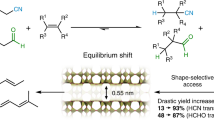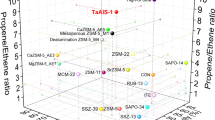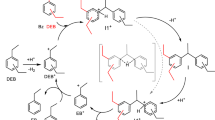Abstract
Catalysis with enzymes and zeolites have in common the presence of well-defined single active sites and pockets/cavities where the reaction transition states can be stabilized by longer-range interactions. We show here that for a complex reaction, such as the conversion of methanol-to-olefins (MTO), it is possible to synthesize reaction-adapted zeolites by using mimics of the key molecular species involved in the MTO mechanism. Effort has focused on the intermediates of the paring mechanism because the paring is less favoured energetically than the side-chain route. All the organic structure-directing agents based on intermediate mimics crystallize cage-based small-pore zeolitic materials, all of them capable of performing the MTO reaction. Among the zeolites obtained, RTH favours the whole reaction steps following the paring route and gives the highest propylene/ethylene ratio compared to traditional CHA-related zeolites (3.07 and 0.86, respectively).
This is a preview of subscription content, access via your institution
Access options
Access Nature and 54 other Nature Portfolio journals
Get Nature+, our best-value online-access subscription
$29.99 / 30 days
cancel any time
Subscribe to this journal
Receive 12 digital issues and online access to articles
$119.00 per year
only $9.92 per issue
Buy this article
- Purchase on Springer Link
- Instant access to full article PDF
Prices may be subject to local taxes which are calculated during checkout





Similar content being viewed by others
References
Stocker, M. Methanol-to-hydrocarbons: catalytic materials and their behavior. Micro. Mesopor. Mater. 29, 3–48 (1999).
Tian, P., Wei, Y., Ye, M. & Liu, Z. Methanol to olefins (MTO): from fundamentals to commercialization. ACS Catal. 5, 1922–1938 (2015).
Ilias, S. & Bhan, A. Mechanism of the catalytic conversion of methanol to hydrocarbons. ACS Catal. 3, 18–31 (2013).
Olsbye, U. et al. Conversion of methanol to hydrocarbons: how zeolite cavity and pore size controls product selectivity. Angew. Chem. Int. Ed. 24, 5810–5831 (2012).
Hemelsoet, K., Van der Mynsbrugge, J., De Wispelaere, K., Waroquier, M. & Van Speybroeck, V. Unraveling the reaction mechanisms governing methanol-to-olefins catalysis by theory and experiment. ChemPhysChem 14, 1526–1545 (2013).
Song, W., Haw, J. F., Nicholas, J. B. & Heneghan, C. S. Methylbenzenes are the organic reaction centers for methanol-to-olefin catalysis on HSAPO-34. J. Am. Chem. Soc. 122, 10726–10727 (2000).
Arstad, B. & Kolboe, S. The reactivity of molecules trapped within the SAPO-34 cavities in the methanol-to-hydrocarbons reaction. J. Am. Chem. Soc. 123, 8137–8138 (2001).
Xu, T. et al. Synthesis of a benzenium ion in a zeolite with use of a catalytic flow reactor. J. Am. Chem. Soc. 120, 4025–4026 (1998).
Song, W., Nicholas, J. B., Sassi, A. & Haw, J. F. Synthesis of the heptamethylbenzene cation in zeolite beta: in situ NMR and theory. Catal. Lett. 81, 49–53 (2002).
Xu, S. et al. Direct observation of cyclic carbenium ions and their role in the catalytic cycle of the metahnol-to-olefin reaction over chabazite zeolites. Angew. Chem. Int. Ed. 52, 11564–11568 (2013).
Chen, J. et al. Elucidating the olefin formation mechanism in the methanol to olefin reaction over AlPO-18 and SAPO-18. Catal. Sci. Tech. 4, 3268–3277 (2014).
Haw, J. F. et al. Roles for cyclopentenyl cations in the synthesis of hydrocarbons from methanol on zeolite catalyst HZSM-5. J. Am. Chem. Soc. 122, 4763–4775 (2000).
Svelle, S. et al. Conversion of methanol into hydrocarbons over zeolite H-ZSM-5: ethene formation is mechanistically separated from the formation of higher alkenes. J. Am. Chem. Soc. 128, 14770–14771 (2006).
Teketel, S., Olsbye, U., Lillerud, K. P., Beato, P. & S., S. Selectivity control through fundamental mechanistic insight in the conversion of methanol to hydrocarbons over zeolites. Micro. Mesopor. Mater. 136, 33–41 (2010).
Zhang, M. et al. Methanol conversion on ZSM-22, ZSM-35 and ZSM-5 zeolites: effects of 10-membered ring zeolite structures on methylcyclopentenyl cations and dual cycle mechanism. RSC Adv. 6, 95855–95864 (2016).
Sassi, A. et al. Methylbenzene chemistry on zeolite HBeta: multiple insights into methanol-to-olefin catalysis. J. Phys. Chem. B 106, 2294–2303 (2002).
Sassi, A., Wildman, M. A. & Haw, J. F. Reactions of butylbenzene isomers on zeolite HBeta: methanol-to-olefins hydrocarbon pool chemistry and secondary reactions of olefins. J. Phys. Chem. B 106, 8768–8773 (2002).
Bjørgen, M., Olsbye, U., Petersen, D. & Kolboe, S. The methanol-to-hydrocarbons reaction: insight into the reaction mechanism from [12C]benzene and [13C]methanol coreactions over zeolite H-beta. J. Catal. 221, 1–10 (2004).
McCann, D. M. et al. A complete catalytic cycle for supramolecular methanol-to-olefins conversion by linking theory with experiment. Angew. Chem. Int. Ed. 47, 5179–5182 (2008).
Arstad, B., Kolboe, S. & Swang, O. Theoretical study of the heptamethylbenzenium ion. intramolecular isomerizations and C2, C3, C4 alkene elimination. J. Phys. Chem. A 109, 8914–8922 (2005).
De Wispelaere, K., Hemelsoet, K., Waroquier, M. & Van Speybroeck, V. Complete low-barrier side-chain route for olefin formation during methanol conversion in H-SAPO-34. J. Catal. 305, 76–80 (2013).
Wang, C. M., Wang, Y. D. & Xie, Z. K. Verification of the dual cycle mechanism for methanol-to-olefin conversion in HSAPO-34: a methylbenzene-based cycle from DFT calculations. Catal. Sci. Technol. 4, 2631–2638 (2014).
Wang, C. M., Wang, Y. D., Liu, H. X., Xie, Z. K. & Liu, Z. P. Theoretical insight into the minor role of paring mechanism in the methanol-to-olefins conversion within HSAPO-34 catalyst. Micro. Mesopor. Mater. 158, 264–271 (2012).
Ilias, S. & Bhan, A. The mechanism of aromatic dealkylation in methanol-to-hydrocarbons conversion on H-ZSM-5: What are the aromatic precursors to light olefins? J. Catal. 311, 6–16 (2014).
Erichsen, M. W. et al. Conclusive evidence for two unimolecular pathways to zeolite-catalyzed de-alkylation of the heptamethylbenzenium cation. ChemCatChem 7, 4143–4147 (2015).
Bhawe, Y. et al. Effect of cage size on the selective conversion of methanol to light olefins. ACS Catal. 2, 2490–2495 (2012).
Kang, J. H. et al. Further studies on how the nature of zeolite cavities that are bounded by small pores influences the conversion of methanol to light olefins. ChemPhysChem 19, 412–419 (2018).
Martin, N. et al. Nanocrystalline SSZ-39 zeolite as an efficient catalyst for the methanol-to-olefin (MTO) process. Chem. Commun. 52, 6072–6075 (2016).
Dusselier, M., Deimund, M. A., Schmidt, J. E. & Davis, M. E. Methanol-to-olefins catalysis with hydrothermally treated zeolite SSZ-39. ACS Catal. 5, 6078–6085 (2015).
Yokoi, T., Yoshioka, M., Imai, H. & Tatsumi, T. Diversification of RTH-type zeolite and its catalytic application. Angew. Chem. Int. Ed. 48, 9884–9887 (2009).
Ji, Y., Deimund, M. A., Bhawe, Y. & Davis, M. E. Organic-free synthesis of CHA-type zeolite catalysts for the methanol-to-olefins reaction. ACS Catal. 5, 4456–4465 (2015).
Liu, M. et al. Differences in Al distribution and acidic properties between RTH-type zeolites synthesized with OSDAs and without OSDAs. Phys. Chem. Chem. Phys. 16, 4155–4164 (2014).
Gallego, E. M. et al. “Ab initio” synthesis of zeolites for preestablished catalytic reactions. Science 355, 1051–1054 (2017).
Zones, S. I. & Nakagawa, Y. Use of modified zeolites as reagents influencing nucleation in zeolite synthesis. Stud. Surf. Sci. Catal. 97, 45–52 (1995).
Li, C., Moliner, M. & Corma, A. Building zeolites from pre-crystallized units: nanoscale architecture. Angew. Chem. Int. Ed. https://doi.org/10.1002/anie.201711422 (2018).
Zones, S. I. Zeolite SSZ-13 and its method of preparation. US Patent 4,544,538 (1985).
Li, Z., Navarro, M. T., Martínez-Triguero, J., Yu, J. & Corma, A. Synthesis of nano-SSZ-13 and its application in the reaction of methanol to olefins. Catal. Sci. Technol. 6, 5856–5863 (2016).
Kumar, M., Luo, H., Román-Leshkov, Y. & Rimer, J. D. SSZ-13 crystallization by particle attachment and deterministic pathways to crystal size control. J. Am. Chem. Soc. 137, 13007–13017 (2015).
Martínez-Franco, R., Cantin, A., Moliner, M. & Corma, A. Synthesis of the small pore silicoaluminophosphate STA-6 by using supramolecular self-assembled organic structure directing agents. Chem. Mater. 26, 4346–4353 (2014).
Schmidt, J. E., Deimund, M. A., Xie, D. & Davis, M. E. Synthesis of RTH-type zeolites using a diverse library of imidazolium cations. Chem. Mater. 27, 3756–3762 (2015).
Moliner, M., Franch, C., Palomares, E., Grill, M. & Corma, A. Cu–SSZ-39, an active and hydrothermally stable catalyst for the selective catalytic reduction of NOx. Chem. Commun. 48, 8264–8266 (2012).
Zhao, Y. & Truhlar, D. G. The M06 suite of density functionals for main group thermochemistry, thermochemical kinetics, noncovalent interactions, excited states, and transition elements: two new functionals and systematic testing of four M06-class functionals and 12 other functionals. Theor. Chem. Acc. 120, 215–241 (2008).
Ditchfield, R., Hehre, W. J. & Pople, J. A. Self-consistent molecular orbital methods. 9. Extended Gaussian-type basis for molecular-orbital studies of organic molecules. J. Chem. Phys. 54, 724–728 (1971).
Hehre, W. J., Ditchfield, R. & Pople, J. A. Self-consistent molecular orbital methods. 12. Further extensions of Gaussian-type basis sets for use in molecular-orbital studies of organic-molecules. J. Chem. Phys. 56, 2257–2261 (1972).
Frisch, M. J. et al. Gaussian 09, Revision C.01. (Gaussian, Wallingford, 2009).
Van Speybroeck, V. et al. First principle chemical kinetics in zeolites: the methanol-to-olefin process as a case study. Chem. Soc. Rev. 43, 7326–7357 (2014).
Acknowledgements
This work was supported by the European Union through ERC-AdG-2014-671093 (SynCatMatch), the Spanish Government-MINECO through Severo Ochoa (SEV-2016-0683) and MAT2015-71261-R. The Electron Microscopy Service of the Universitat Politècnica de València (UPV) is acknowledged for their help in sample characterization. C.L. acknowledges the China Scholarship Council for a PhD fellowship.
Author information
Authors and Affiliations
Contributions
A.C. conceived and directed the project. M.M. and A.C. designed the synthesis and M.M. directed the zeolite synthesis work. C.P. carried out the synthesis of the organic molecules. C.L. performed the zeolite synthesis. C.L. and J.M.-T. performed the MTO catalytic experiments. M.B. carried out the theoretical calculations. M.M., M.B. and A.C. wrote the manuscript. C.L., C.P., J.M.-T., M.B., M.M. and A.C. participated in the discussion and interpretation of the experimental data.
Corresponding author
Ethics declarations
Competing interests
The authors declare no competing interests.
Additional information
Publisher’s note: Springer Nature remains neutral with regard to jurisdictional claims in published maps and institutional affiliations.
Supplementary information
Supplementary Information
Supplementary Figures 1–24, Supplementary Tables 1–6, Supplementary Methods, Supplementary References
Rights and permissions
About this article
Cite this article
Li, C., Paris, C., Martínez-Triguero, J. et al. Synthesis of reaction‐adapted zeolites as methanol-to-olefins catalysts with mimics of reaction intermediates as organic structure‐directing agents. Nat Catal 1, 547–554 (2018). https://doi.org/10.1038/s41929-018-0104-7
Received:
Accepted:
Published:
Issue Date:
DOI: https://doi.org/10.1038/s41929-018-0104-7
This article is cited by
-
Synthesis of Nano-sheet SAPO-34 Zeolites Via Aminothermal Method and Its Methanol to Olefins (MTO) Performance
Catalysis Letters (2024)
-
Approaching enzymatic catalysis with zeolites or how to select one reaction mechanism competing with others
Nature Communications (2023)
-
Direct assessment of confinement effect in zeolite-encapsulated subnanometric metal species
Nature Communications (2022)
-
Modulating inherent lewis acidity at the intergrowth interface of mortise-tenon zeolite catalyst
Nature Communications (2022)
-
Theoretical design for zeolite synthesis
Science China Chemistry (2022)



